![]()
![]()
First TWO letters: (General Theme Park or Type of Plate)
AG = Autographed Plates
AT = Attraction Plates
BK = Bicycle Plates
CM = Cast Member Exclusive Plates
DC = Disney Cruise Line Plates
DL = Disneyland, Anaheim, CA Plates
DP = Disneyland Paris Plates (formerly Euro Disney) (France)
DR = Disney Resort Plates (Resorts outside of Theme Park Properties)
DS = Disney Studios in California and Florida
DW = Walt Disney World, Lake Buena Vista, FL Plates
ED = Euro Disney Plates (now known as Disneyland Paris)
HK = Hong Kong Disneyland (China)
MI = Miscellaneous Plates
OT = Other License Plate Item
PR = Disney Property Plates
PT = Prototype Plates
SP = Disney Sports Plates
TD = Tokyo Disney Resort Plates (Japan)
VR = Virtual Digital Plates
Third and Fourth letters: (Specific Theme Park or Type of Plate)
23 = D23 Convention
AA = Anaheim Angels (baseball)
AK = Animal Kingdom at Walt Disney World
CA = California Adventure (theme park next to Disneyland)
CC = Castaway Cay (Disney Cruise Line stopover island)
CT = Disney Catalog
DC = Disney Cruise Line
DD = Downtown Disney at Walt Disney World and Disneyland Resort Anaheim
DL = Disneyland, Anaheim, CA Plates
DW = Walt Disney World
EC = Epcot Center at Walt Disney World (now known as just "Epcot")
EP = Epcot at Walt Disney World (formerly known as Epcot Center)
ES = ESPN Zone
FR = License Plate Frames
GF = Golf
GN = General Plates
HS = Hollywood Studios at Walt Disney World (formerly known as MGM Studios)
IN = Indy 200 (auto racing) at Walt Disney World Raceway
LP = License Plate Item
MD = Mighty Ducks (hockey)
MG = Disney/MGM Studios Theme Park at Walt Disney World (now known as Hollywood Studios)
MI = Miscellaneous Plates
MK = Magic Kingdom (from all major theme parks)
OT = Other Plates
PI = Pleasure Island at Walt Disney World
RS = Resort Hotel
SC = Sports Center (ESPN's flagship program)
SE = Tokyo DisneySea Theme Park (Japan)
SP = Sports Plates
ST = Disney Store
WP = Water Parks
WS = World Showcase in Epcot at Walt Disney World
WW = Disney's Wide World of Sports Complex
Numbers
For numerical sequence/order
As of June 30, 2024 there are 835 known Disney license plates. 493 of the 835 license plates originated from Walt Disney World. Walt Disney World is the only Disney property still producing and selling license plates on a semi-regular basis. Disneyland, Disneyland Paris and Tokyo Disneyland are no longer producing or selling license plates due to the lack of public demand. Hong Kong Disneyland has yet to produce or release any license plates. However, Disneyland is still producing frames also on a semi-regular basis. See Resources for additional information.
Specialty or special occasion license plates (such as the Polynesian 25th Anniversary) are not intended for sale to the public on or off property, but are souvenirs solely for resort guests or a selected group. These specialty plates are usually requested/ordered by the upper management staff of the celebrating area or resort for a specific event. Therefore, many of these plates remain unknown to collectors.
In November of 2017, Merchandise Guest Services stopped taking phone orders for merchandise and now is only selling "selected" merchandise on-line at Shop Disney websites and computer applications to those "Guests" not visiting the parks.
Most of the aluminum plates have an ID number printed on them. The ID Number is usually found on the front of the license plate in the lower left hand corner. Some of the license plates have two versions that exist, one with and one without plate ID numbers. However, there are aluminum plates that do not have an ID number. Plastic plates do not have ID numbers at all.


The ID number appears to be a number assigned by the manufacturer and not a number assigned by Disney. Similar style ID numbers appear on non-Disney aluminum plates. There are two styles of ID numbers. The first style, which is seen on older issued plates, is a string of numbers, up to 5 digits. The second style that is seen on the newer plates is a hyphenated combination of letters and numerals.
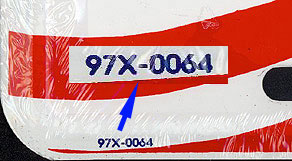
It is believed that the first two numbers of the newer ID number are the year of manufacture. The year of manufacture is followed by a letter, (letters A through L and X are used), which seems to be the month in which the plate was made. "A" would equal January and "L" would be December. "X" appears to be used for plates that are continually manufactured and not a one-time production like most Disney plates are, and therefore, no month designation is defined.

The month letter is then followed by at least 4 numbers, which seems to be a chronological sequence of manufacture. There may be a suffix letter following the chronological sequence number. The purpose of the suffix letter is not clear.
An opening drilled through the plate to allow attachment to a vehicle. Slots are more common than holes, since they allow for attachment to various kinds of vehicles with various styles of license plate holders. Bolt holes provide fixed attachment points and don't allow flexibility in attachment to vehicles.
A unique "Mouse Ear" bolt hole has appeared on plates issued from the Tokyo Disney Resort in Japan. These tiny holes are designed to keep the Tokyo Disney plates from being used on automobiles. So far these "Mouse Ear" bolt holes are exclusive to the Tokyo plates.



Plastic license plates appear to be replacing the stamped aluminum license plates. Plastic license plates are sold without shrink-wrap. Generally they have bolt holes rather than "slots" to allow attachment to vehicles. As of June 30, 2024, there are 234 known plastic license plates listed in the catalog.
Note: As of 2004, the plastic plates were limited in release. Of the seventeen new releases in 2004, fifteen were produced in aluminum. The plastic plate trend may be reversing itself. For 2005, thirteen new plates were released, among them were seven plastic plates. For 2006, there were nine new Disney plates released and of those nine, six were plastic plates. For 2007, there were eight new Disney plates released and of those eight, four were plastic plates. In 2008, there were only five Disney plates released and two of those were made of plastic. For 2009, there were only three Disney plates released and they were all made of aluminum, no plastic plates were produced for 2009. In 2010, there were only three Disney plates released and they were all made of aluminum/metal, no plastic plates were produced for 2010. For 2011 there was six license plates released and they were all made of aluminum/metal, no plastic plates were produced for 2011. In 2012 there were four license plates released and they were all made of aluminum/metal. For 2013 only one plastic license plate was produced. In 2014 there were only three license plates that were released and none of them were made of plastic.
Found on the back of most or all of the Disneyland license plates and several plates from Walt Disney World is a warning label providing information on the prohibited use of the commemorative license plates.



Those plates that were verified with warning labels attached are noted in the plate listings.
The original blue and white WDW opening day license plate (on the left) was removed from sale and discontinued due to its resemblance to the official 1970-71 State of Florida license plate (on the right).


It also seems that Disney used the background colors from several earlier official State of Florida license plates (on the right) to create the WDW opening license plates (on the left).

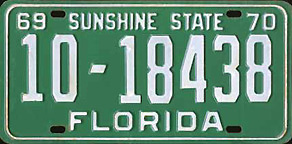

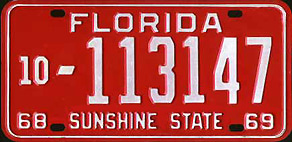
Most license plates are sold with shrink-wrap. The ideal collectible license plates are those with the shrink-wrap intact and with price tag/sticker attached.
Condition Terms
Mint: In its condition as sold, with shrink-wrap. Shrink-wrap may be torn, but is still secured around plate. Some plates, such as the plastic versions, were released without shrink-wrap. They would be considered mint if they meet the Excellent standard.
Excellent: Shrink-wrap totally removed or torn where shrink-wrap is not secured around plate. No scratches, scuff marks, dings, dents, bent edges or places and not missing any paint. Otherwise plate would be considered Mint if shrink-wrap was intact.
Good: Shrink-wrap totally removed. Slight scratches, scuff marks, dings, dents, bent edges or places. Not missing any paint. No signs of use on a vehicle. No damage to bolt holes/slots.
Average: Shrink-wrap totally removed. Signs of wear visible: scratches, scuff marks, dings, dents, bent edges or places. May have small areas missing some paint. May have also been used on a vehicle. Some minor damage to bolt holes/slots.
Used: Shrink-wrap totally removed. Signs of major wear visible: scratches, scuff marks, dings, dents, bent edges or places. Has areas of missing paint. Used on a vehicle, bolt holes/slots enlarged or damaged by use.
Disney License Plates have been included in the "Hidden Mickey" craze that began in the 1980's by Disney Imagineers. Starting out as inside jokes, silhouettes of the famous "Mickey Mouse Ears" have been cleverly and unobtrusively included in several of the attractions within the parks. The disguised silhouettes were placed among artwork, on walls and in displays and soon became an "attraction" in their own right with park guests searching for these elusive "Hidden Mickeys."
The craze has also developed into a search for a common set of three circles forming the classic "Mickey Mouse Ear" shape. Most of these discoveries are design flukes and were not intentionally placed there in disguise. See the Hidden Mickeys on Disney License Plates Page.
For the purposes of this website, a Hidden Mickey is a subtle formation of a silhouette of the head of Mickey Mouse and his two ears that is concealed in the design of a Disney License Plate.
Designers have intentionally incorporated Mickey’s silhouette image into many of the Disney License Plates and they are intended to make Mickey part of the artwork or are used as a Disney identifying logo. Intentional Mickeys are those that are clearly visible and are not concealed in the artwork. Intentional Mickeys are not included on the Hidden Mickeys Disney License Plates page.
Below are examples of a Hidden Mickey and an Intentional Mickey.
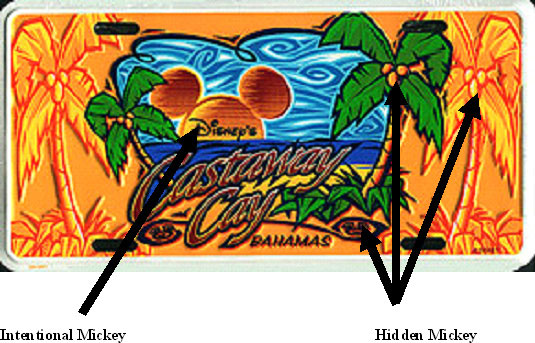
Back in 2010 Disney License Plate items (plates and frames) were released with a “unique ID number” printed on the back of the plate or frame. At the time there was no explanation of the number and its meaning. The number continues today to be printed on the back of license plate items.
Disney was asked about the number, but the reply was “we do not know” or they were not going to state the purpose of the number.
As of April in 2012, we have seen nine license plates and nine frames with the unique number printed on the back.
There is a common theme among the numbers used and here is what I believe the numbers to stand for.

The top number, “H129-7443-4”, is either a manufacturer ID number or the ID number assigned to Disney. It is always on the top and has been seen on all of the plates and frames.
The bottom set of numbers, “10309”, as seen in the above example, denotes the production date and year. The “10” would be the year (2010) and the “309” would be the 309th day of 2010. “309” translates to being November 5th. This would mean that this plate was produced on November 5, 2010.
There have been two styles of the bottom number seen on the eighteen license plate items.

The “year” and the “day of the year” have swapped positions, with the “day of year” appearing before the “year”.
The “year” and the “day of the year” have also been printed next to or close to each other as well and being separated by several blank spaces.

The “unique ID number” has also been found to have been printed more than once on certain items. The DC-GN-08 license plate has been found with one number, with two identical number sets and then with three identical number sets printed on the back. Most of the frames have two identical number sets printed on them.
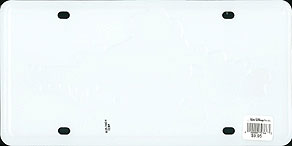



In late 2015 another unique ID number appeared on Disney License Plates and Frames. So far we have seen four of these unique numbers appearing on both frames and plates. While I still don't understand the meaning or purpose for the number, I believe that the second number set designates the production date. The second number set has been consistent on the four sets that have been seen so far.
The numbers seen so far are:
DW-GN-46: FAC-018799-15238 (on front);
DL-FR-40: FAC-029112-15238 (on back);
DS-FR-10: FAC-015393-15296 (on back);
EP-FR-06: FAC-025063-16158 (on back).




The second set (last five numbers) for the DW-GN-46 plate indicate that the plate was manufactured on August 26, 2015. The first two numbers in the set (15) would indicate the year of manufacture of 2015. The next three numbers (238) would indicate the day of the year of August 26th.
I had initially thought that the numbers were a Chinese system as the DW-GN-46, DL-FR-40 and DS-FR-10 were made in China. However, the EP-FR-06 was made in the United States.
An Internet search did not reveal what the "FAC" might mean in relationship to Disney License Plates and Frames. I have not been able to get Disney to disclose the purpose or meaning of the unique number.
The Day of the Year Perpetual Calendar chart converts the “day of the year” number to the actual calendar date and shows the “day of the year” for normal and leap years.